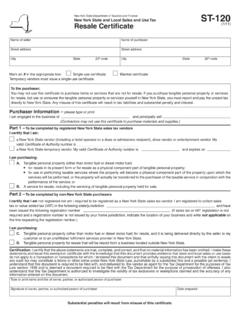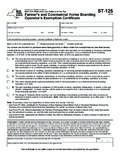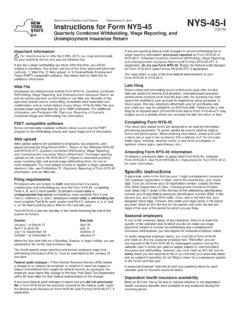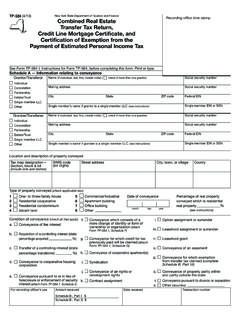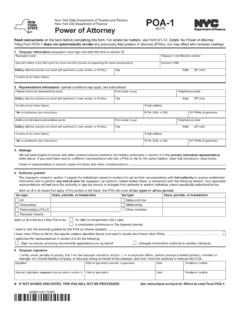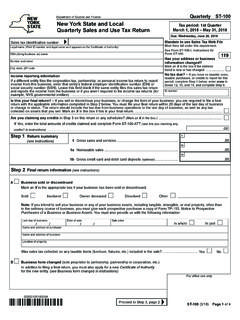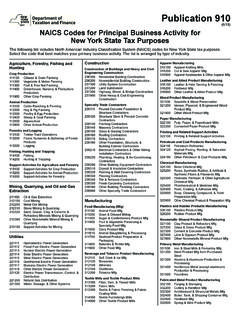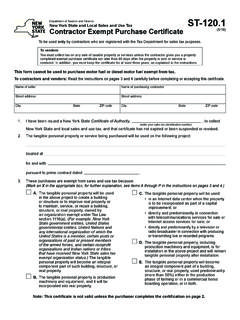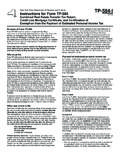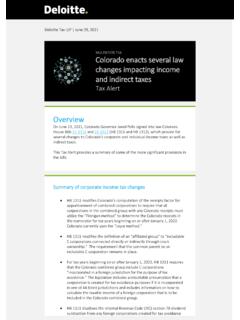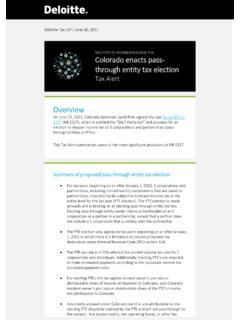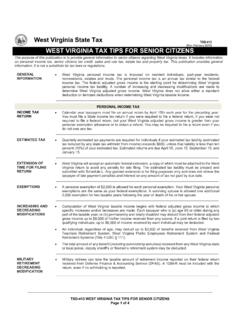Transcription of Publication 420:(8/15):Guide to the Metropolitan Commuter ...
1 Publication 420 Guide to the Metropolitan CommuterTransportation Mobility TaxPub 420 (8/15)Note: A Publication is an informational document that addresses a particular topic of interest to taxpayers. Subsequent changes in the law or regulations, judicial decisions, Tax Appeals Tribunal decisions, or changes in department policies could affect the validity of the information contained in a Publication . Publications are updated regularly and are accurate on the date issued. The information provided in this document does not cover every situation and is not intended to replace the law or change its 420 (8/15) Table of Contents Page I. Introduction .. 5 General .. 5 SUNY Tax-Free Areas to Revitalize and Transform Upstate New York (START-UP NY) program .. 5 II. Employers .. 6 General .. 6 Definitions .. 6 Employers of household help .. 7 Leased employees .. 7 Third-party sick pay .. 7 Determining if an employee is a covered employee .. 7 Computing the amount of payroll expense.
2 9 Payments not considered wages for purposes of the MCTMT .. 10 MCTMT rates .. 11 Computation of the MCTMT for professional employer organizations .. 12 Prohibition from deducting MCTMT from employees wages or compensation .. 12 Quarterly filing requirements and payment of the MCTMT .. 12 Employers not required or electing to participate in the PrompTax program .. 13 PrompTax filers .. 13 Penalties and interest .. 15 Collection of debts from an overpayment of MCTMT .. 15 Amending MCTMT returns .. 15 Treatment of the MCTMT on New York State tax returns .. 16 III. I ndividuals with net earnings from self-employment .. 16 General .. 16 Definitions .. 17 Net earnings from self-employment Special situations .. 18 Nonresident aliens .. 18 Certain church employees .. 18 Members of the clergy and Christian Science practitioners .. 18 Allocation of net earnings from self-employment .. 18 Tax rate .. 19 Estimated MCTMT payments .. 19 Penalty for underpayment of estimated MCTMT.
3 20 Reporting annual MCTMT information .. 20 Penalties and interest .. 21 Overpayments of tax .. 21 Collections of debts from an overpayment of tax .. 21 Amending MCTMT information .. 22 Treatment of the MCTMT on New York State personal income tax returns .. 22 3 Publication 420 (8/15) Table of Contents (continued) Page IV. Special rules for partnerships and partners .. 22 General .. 22 Net earnings from self-employment .. 23 Guaranteed payments to nonresident alien partners .. 23 Estimated MCTMT payments made on behalf of nonresident individual partners .. 23 Form IT-203-GR, Group Return for Nonresident Partners .. 24 Group overpayments of MCTMT .. 25 Amending MCTMT information on a group return .. 25 4 Publication 420 (8/15) I. Introduction This Publication provides guidance, with regard to computing, reporting, and paying the Metropolitan Commuter transportation mobility tax (MCTMT) for tax years beginning on or after January 1, 2015. For tax years beginning before January 1, 2015, see: TSB-M-09(1)MCTMT, Metropolitan Commuter Transportation Mobility Tax, and TSB-M-12(1)MCTMT, Legislative Amendments to the Metropolitan Commuter Transportation Mobility Tax.
4 To receive e-mail notifications containing links to newly posted MCTMT information, visit the Tax Department Web site ( ) and Subscribe to our e-mail service. See Need help? on the back cover for information on obtaining forms, instructions, and publications from the Tax Department. General The MCTMT is administered by the New York State Tax Department. However, the proceeds from this tax are distributed to the Metropolitan Transportation Authority. The MCTMT is imposed on certain employers and individuals engaging in business within the Metropolitan Commuter transportation district (MCTD). The MCTD includes New York City (the counties of New York (Manhattan), Bronx, Kings (Brooklyn), Queens, Richmond (Staten Island)), and the counties of Rockland, Nassau, Suffolk, Orange, Putnam, Dutchess, and Westchester. Note: Except for certain START-UP NY tax benefits, any exemption from tax allowed in any other New York State law does not apply to this tax. For example, if another law states that a certain New York public authority is exempt from any tax imposed by New York State or any political subdivision of the state, that exemption does not apply to the MCTMT.
5 Additionally, no tax credit(s) may be used to reduce the amount of the MCTMT due. SUNY Tax-Free Areas to Revitalize and Transform Upstate New York (START-UP NY) program Chapter 68 of the Laws of 2013 established the START-UP NY program. Approved businesses in the START-UP NY program that are located in a tax-free NY area within the MCTD are eligible for an exemption from the MCTMT. Employers. The MCTMT exemption eliminates the MCTMT on the payroll expense attributable to an approved business location within the MCTD for 40 consecutive calendar quarters, beginning with the calendar quarter the business locates in a tax-free NY area. 5 Publication 420 (8/15) Self-employed individuals. The MCTMT exemption eliminates the MCTMT on net earnings from self-employment attributable to an approved business location within the MCTD for 10 consecutive years, beginning with the tax year the business locates in a tax-free NY area. Employers and self-employed individuals who meet the MCTMT filing requirements discussed in this Publication must report MCTMT information and file MCTMT returns with the department even if no tax is due.
6 For more information, including specific MCTMT reporting and filing requirements for approved businesses in a tax-free NY area, visit the START-UP NY program page on the Tax Department Web site. II. Employers General Employers are liable for the MCTMT for a calendar quarter if they are required to withhold New York State income tax from wages paid to employees and their payroll expense for all covered employees exceeds $312,500 for that calendar quarter. An employer whose payroll expense for a quarter does not exceed $312,500 is not subject to the MCTMT for that quarter. This is true even though the employer s payroll expense may have been more than $312,500 in a previous quarter. Definitions The following definitions apply to the MCTMT for employers: Employer means any employer required by section 671 of the Tax Law to deduct and withhold tax from wages that has a payroll expense of more than $312,500 in any calendar quarter. However, agencies and instrumentalities of the United States; the United Nations; interstate agencies and public corporations created pursuant to an agreement or compact with another state or Canada; and eligible educational institutions are not subject to the MCTMT.
7 Note: F or an employer to be considered an agency or instrumentality of the United States, a federal law must specifically state that the employer is an agency or instrumentality of the United States, or a decision in a federal court case must specifically state that the employer is an agency or instrumentality of the United States. (If there is a question on whether an employer is subject to the MCTMT under this definition, a request for an advisory opinion from the department may be made by filing Form , Petition for Advisory Opinion.) An eligible educational institution means any public school district; a board of cooperative educational services (BOCES); a public elementary or secondary school; a school approved pursuant to Article 85 or 89 of the Education Law to serve students with disabilities of school age; or a nonpublic elementary or secondary school that provides instruction in grade one or above. 6 Publication 420 (8/15) Payroll expense for covered employees subject to federal social security taxes means wages and compensation as defined in section 3121 of the Internal Revenue Code (IRC), without regard to section 3121(a)(1).
8 Section 3121 defines wages and compensation subject to federal social security taxes. However, in computing payroll expense, the cap on the amount of wages subject to social security taxes contained in section 3121(a)(1) of the IRC does not apply. Accordingly, for most employers, payroll expense is the amount of the employee wages or other compensation that is subject to the Medicare portion of the social security taxes. Payroll expense for covered employees subject to the railroad retirement tax means the total wages and compensation as defined in section 3231 of the IRC, without regard to section 3231(e)(2)(A)(i). Section 3231 defines wages and compensation subject to federal railroad retirement tax. However, in computing payroll expense, the cap on the amount of wages subject to the railroad retirement tax contained in section 3231(e)(2)(A)(i) of the IRC does not apply. Covered employee means an employee (including a statutory employee) whose services are allocated to the MCTD (see Determining if an employee is a covered employee below).
9 Employers of household help Employers of household help are not required to deduct and withhold income tax from wages paid to household employees. Withholding income tax (federal or New York State) from wages paid to household employees is voluntary on the employer s and the employee s part. Therefore, employers of household help are not subject to the MCTMT on the payroll expense attributable to household employees. Leased employees The determination of who is liable for the MCTMT for the payroll expense related to the wages or other compensation paid to a leased employee is based on who is liable for the filing and payment of the social security tax. Accordingly, the employer who is liable for the filing and payment of social security tax is the employer liable for the MCTMT on the payroll expense for the leased employee. Third-party sick pay The determination of who is liable for the MCTMT for the payroll expense related to the payment of third-party sick pay to an employee is based on who is liable for the filing and payment of the social security tax.
10 Accordingly, the employer who is liable for the filing and payment of social security tax is the employer liable for the MCTMT on the payroll expense for the employee. Determining if an employee is a covered employee An employee, including a statutory employee, is considered to be a covered employee if the employee s services are allocated to the MCTD. To determine if an employee s services are allocated to the MCTD, apply the following tests in the order presented below. If any test results in the allocation of the employee s services to the MCTD, the employee is a 7 Publication 420 (8/15) covered employee and no further test need be applied. Otherwise, proceed to the next succeeding test. 1) Localization An employee s services are allocated to the MCTD if those services are (1) performed entirely within the MCTD or (2) performed both in and outside of the MCTD, but the services performed outside the MCTD are incidental to the employee s services performed within the MCTD (for example, are temporary or transitory in nature or consist of isolated transactions).
